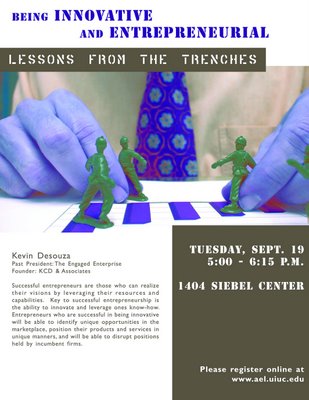Demystifying the Link between Innovation and Business Value
We are ready to get started on our next project. On behalf of the entire research team, I would like to thank the i3m partners for deciding to fund this project. We are looking forward to an exciting few months and hope to create actionable knowledge of value.
Here is a brief synopsis of our new effort:
Two universal truths underpin most business operations: (1) unless businesses can demonstrate value to their stakeholders on a constant basis they will lose customers and markets, get overrun by the competition, and eventually become extinct, and (2) to generate business value, an organization must constantly innovate, and do so in an effective and efficient manner. Finding support for these truths is not difficult; consider the following comments by two seasoned executives:
“I know we need to show value…today we are being evaluated in 30 or 60 day intervals. The days of doing one-year projects that pay off two years from now are long gone…my boss wants to know how the money I am spending today is getting us returns next week, next month, or at best, next three months…I need to be able to show the value for this so-called innovation.”
– VP of Research & Development, Information Technology Organization
“Innovation…sure, I think it contributes to the business value…If I did not think so, I would not be here talking to you. But, I would not know how to show you on paper the linkage…I mean we know that it [innovation] does lead to business value, if we did not we would not spend on it…we are rational beings…but every board meeting I struggle to communicate the value of the innovation…The link is so elusive…It is touchy-feely but not concrete.”
– CIO, Financial Services Organization
Such quotes, and several more from our current research project, Leveraging Ideas for Organizational Innovation, help to deduce another truth. Regardless of departmental function (e.g. IT, Sales, Operations, etc), most executives lack good mechanisms for (1) measuring the business value of innovations, and (2) communicating the value of innovation projects. Over 85% of the executives we interviewed requested that research be conducted to identify solutions that can address these two issues. These issues are salient for a number of reasons.
Inability to measure the business value of innovation limits an organization’s ability to build effective innovation programs. Resources spent on innovation may be underutilized or ineffectively utilized. In addition, resources spent on innovation may conflict or compete with other organizational efforts. Moreover, outcomes of innovation efforts may be nothing more than good ideas, which may never get commercialized or diffused, thereby limiting any returns on the original investment.
Not being able to communicate the value of resources spent on innovation makes executives vulnerable. First, the executives will not be able to convince their external stakeholders that current resources directed towards innovation efforts will secure a better position for the organization’s future. Second, and equally important, rallying support from their peer-executives on innovation projects will be very difficult, if not impossible. The linkage on monies spent and bottom-line value, both in terms of operational gains and strategic advantages, will be elusive. Third, being able to communicate to the employees of the organization and set a consistent vision, mission, and agenda for corporate innovation will be difficult. Without clear metrics, an innovation program is not clearly understood, not supported by the executives, and not embraced by the employees. Clearly, without metrics an innovation program is fundamentally flawed.
The goal of this research project will be to uncover mechanisms that can be used to (1) link innovation to business value, and (2) communicate the value of innovation.








